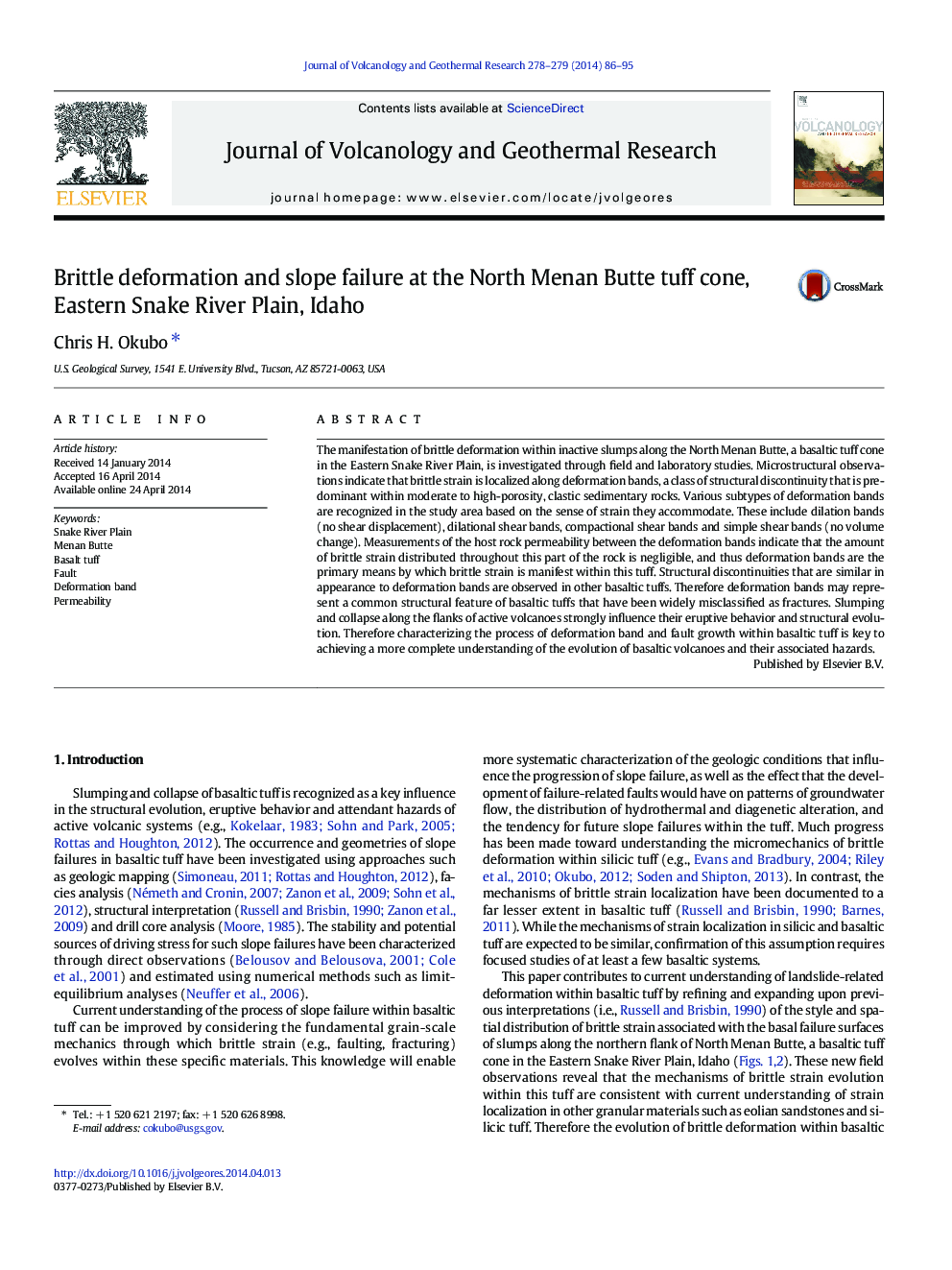| کد مقاله | کد نشریه | سال انتشار | مقاله انگلیسی | نسخه تمام متن |
|---|---|---|---|---|
| 6439941 | 1638343 | 2014 | 10 صفحه PDF | دانلود رایگان |
عنوان انگلیسی مقاله ISI
Brittle deformation and slope failure at the North Menan Butte tuff cone, Eastern Snake River Plain, Idaho
ترجمه فارسی عنوان
تغییر شکل ضعیف و شکاف شیب در مخروط توف شمال مونتان بوت، دشت شرقی مارین، آیداهو
دانلود مقاله + سفارش ترجمه
دانلود مقاله ISI انگلیسی
رایگان برای ایرانیان
کلمات کلیدی
ترجمه چکیده
تظاهرات تغییر شکل شکنندگی در ناحیه غیر فعال در امتداد شمال منانت باته، مخروط توف بازالت در دشت شرقی شرقی، از طریق مطالعات میدانی و آزمایشگاهی مورد بررسی قرار گرفته است. مشاهدات میکروارگانیسم نشان می دهد که کرنش شکننده در امتداد نوارهای تغییر شکل، یک طبقه از انقباض ساختاری است که در دره های متوسط تا بالا، سنگ های رسوبی کلاسیک غالب است. زیرمجموعه های مختلف باند های تغییر شکل در منطقه مورد مطالعه بر اساس حس کرنش آنها مطابقت دارند. این شامل باند های انعقاد (بدون جابجایی برشی)، باند های برش دهلیزی، باند برشی فشرده و نوارهای برش ساده (بدون تغییر حجم). اندازه گیری نفوذ پذیری سنگ میزبان بین نوارهای تغییر شکل نشان می دهد که مقدار کرنش شکننده در این قسمت از سنگ، ناچیز است و بنابراین نوارهای تغییر شکل، ابزار اصلی هستند که از طریق آن کشش شکننده در این توف نشان داده می شود. اختلاط سازه ای که در ظاهر مشابه با نوارهای تغییر شکل در دیگر توف های بازالت مشاهده می شود. بنابراین باند های تغییر شکل ممکن است یک ویژگی ساختاری مشترک توده های بازالتی را نشان دهند که به طور گسترده ای به عنوان شکستگی طبقه بندی شده اند. انفجار و فروپاشی در امتداد جبهه های آتشفشان فعال، به شدت بر رفتارهای فوران کننده و تکامل ساختاری تاثیر می گذارد. بنابراین توصیف فرآیند تغییر شکل باند و گسل در توف بازالتی، کلیدی برای رسیدن به درک کامل تری از تکامل آتشفشان های بازالتی و خطرات مربوط به آنها می باشد.
موضوعات مرتبط
مهندسی و علوم پایه
علوم زمین و سیارات
ژئوشیمی و پترولوژی
چکیده انگلیسی
The manifestation of brittle deformation within inactive slumps along the North Menan Butte, a basaltic tuff cone in the Eastern Snake River Plain, is investigated through field and laboratory studies. Microstructural observations indicate that brittle strain is localized along deformation bands, a class of structural discontinuity that is predominant within moderate to high-porosity, clastic sedimentary rocks. Various subtypes of deformation bands are recognized in the study area based on the sense of strain they accommodate. These include dilation bands (no shear displacement), dilational shear bands, compactional shear bands and simple shear bands (no volume change). Measurements of the host rock permeability between the deformation bands indicate that the amount of brittle strain distributed throughout this part of the rock is negligible, and thus deformation bands are the primary means by which brittle strain is manifest within this tuff. Structural discontinuities that are similar in appearance to deformation bands are observed in other basaltic tuffs. Therefore deformation bands may represent a common structural feature of basaltic tuffs that have been widely misclassified as fractures. Slumping and collapse along the flanks of active volcanoes strongly influence their eruptive behavior and structural evolution. Therefore characterizing the process of deformation band and fault growth within basaltic tuff is key to achieving a more complete understanding of the evolution of basaltic volcanoes and their associated hazards.
ناشر
Database: Elsevier - ScienceDirect (ساینس دایرکت)
Journal: Journal of Volcanology and Geothermal Research - Volumes 278â279, 15 May 2014, Pages 86-95
Journal: Journal of Volcanology and Geothermal Research - Volumes 278â279, 15 May 2014, Pages 86-95
نویسندگان
Chris H. Okubo,
